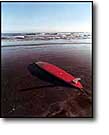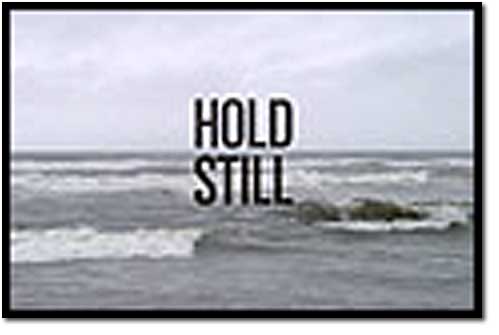Vancouver Art Gallery,
Jun 05, 2004 - Aug 29, 2004
Vancouver, BC, Canada
Baja to Vancouver
by Cassandra Coblentz
The notion of terrain or landscape is more readily addressed by artists in the exhibition Matt McCormick’s captivating mock documentary film, The Subconscious Art of Graffiti Removal takes the industrial waterfront of Portland as it’s subject. Exploring the vast and desolate urban industrial environment, McCormick’s film takes a subtly sarcastic ethnographical approach to the systematic way city officials of Portland have painted over graffiti. Mocking the desire for control on the part of the city as well as the bizarre orderliness of this approach to suppressing urban expression, McCormick’s narrator classifies the graffiti removal into types, drawing out formal parallels with modernist painters such as Mark Rothko and Alexander Rodchenko. Slow deliberate panning shots following a lone bicyclist as she casually rides through the barren industrial landscape are intercut with expository moments classifying and analyzing the various types and occurrences of graffiti removal. This self conscious cinematic gesture creates a sense of idyllic wistfulness, enhancing the ironic tone of the work.
Tijuana based Torolab also uses irony to directly addresses a specific socio-political environment. As a collective Torolab creates multi-media/cross disciplinary works that have a utopian goal of improving the quality of life for residents of Tijuana and the entire California border region. Torolab’s collaborations, which take such forms as graphic design, clothing, experimental architecture and text; retain a subtle ironic criticism that enables their self conscious mocking to function on various levels of engagement with issues around art and politics. With their well-designed gear, they also reference utopian modernist ideal that good design can provide a viable solution real issues such as poverty and homelessness. Torolab is represented in the exhibition by a white manikin wearing an "urban Survival Unit" which consists of a hexagonal shaped enhanced backpack the unfolds to become a portable shelter, a collapsible tent designed to fit in the hidden spaces behind and between Tijuana’s many billboards. Positioned in front of silver reflective decals in the form of telephone poles, the white manikin appears like a well-equipped Sierra Club adventurer, ready to confidently tackle the urban wilderness. That there is no reference to ethnicity or class with this pristine white stand-in even further emphasizes how far from the reality Torolab’s fantasy of the Urban Survival unit is…but then again, maybe that’s the whole point.
The installation of the exhibition is organized loosely around a set of sub-headings that posit themes and commonalities among the works such as The Culture of Nature, Edge City, Pop-Media Culture, The Other Side of Counter Culture or Culture of Individualism. A label in each gallery explains these sub-themes however not all of the works in that gallery are the works discussed in the label or can even be considered to relate to the topic being discussed. Also the emphasis on the term culture implies some commonalties being drawn out between the various modes of expression. On one hand this gesture can be seen as allowing for an open and fluid interpretation, but such tentative schematics really only very vaguely suggest commonalities and mostly falls short of stating anything definitively.
The many gestures towards inclusion and openness, makes clear an intent to avoid making generalizations and falling prey to the traps of regional stereotypes. Through a conscious strategy of allowing for an open-ended approach to the work, the show deliberately goes out its way to draw out differences as opposed to similarities. It is clear that the curators took the notion of subjectivity very seriously. No work better exemplifies the impossibility of objective common understanding than Trisha Donnelly’s Blind Friends. The piece is essentially a photographic documentation of a kind of per formative sociological experiment in which Donnelly brought 50 blind people to the beach and asked them to walk in the direction of the wind. Needless to say, they all set off in 50 different directions. Perhaps like Donnelly’s subjects, Baja to Vancouver’s approach to the art of this region, demonstrates only the range of diversity and disparity that permeates it. This exhibition travels from the Seattle Art Museum to the San Diego Museum of Contemporary Art, the Vancouver Art Gallery, and finally the Wattis Insitute for Contemporary Art at the CCA in San Francisco.
|







